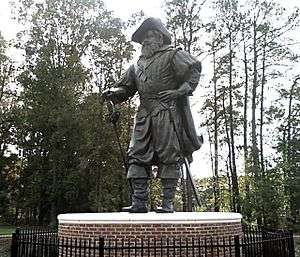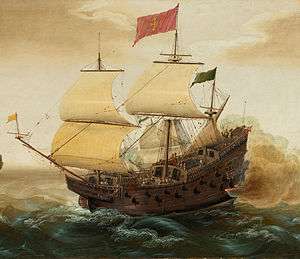Battle of Puerto Caballos (1603)
The Battle of Puerto Caballos was a military event during the Anglo–Spanish War to capture the Spanish town and port of Puerto Caballos (present day Puerto Cortés, Honduras) on 17 February 1603 by an English fleet under Christopher Newport and Michael Geare. The English were able to achieve victory after a bitter fight. Two Spanish galleons were captured, one of which was subsequently burned. The Anglo-French consortium occupied the area and after two weeks withdrew with captured booty.[2]
Background
With the Anglo-Spanish war still raging, English privateers were harassing Spanish shipping. These were mainly London merchants who, in a grinding war of attrition, were still able to roam the coast of the Spanish New World. In charge of one of these expeditions was veteran Christopher Newport who had been in the Caribbean since 1602 and had continually returned. He had lost his arm during a successful expedition in 1590 but this did not still stop him from fighting.[7]
In November 1602, at the smuggling outpost of Tortuga at northern Hispaniola, Newport had teamed up with Captain Michael Geare (another veteran of raiding the Spanish Main) who himself had teamed up with three French slavers to attack a pair of Spanish galleons expected soon at Puerto Caballos (modern-day Puerto Cortés, Honduras).[3] The 300- to 350-ton English vessels – Archangel of Geare, Newport's Neptune, and Anthony Hippons in Paul Bayning's ship Phoenix—were joined by Spanish prizes to increase their fleet's size to eight.[1]
Newport had successfully raided Puerto Caballos before in May 1592, where he captured a 200-ton merchantmen. He knew the area well but the fleet needed supplies badly so they headed first for Jamaica. On 24 January 1603, while heading for Puerto Caballos, the Anglo-French flotilla raided Jamaica. The Spanish repelled the attack. Newport and his associates withdrew with minor losses.[1]
Engagement
In the dark on 17 February the English ships followed by the French slavers reached the port of Puerto Caballos and detached seven boats with 200 men and light artillery. They hoped to board the two partially laden Spanish galleons at anchor in the roads rather than destroy them. The galleons were Captain Juan de Monasterios's 600-ton Nuestra Señora del Rosario and Francisco Ferrufino's 400-ton San Juan Bautista.[1] These were the flagship and vice flagship of the flota of New Spain.[3] At almost sunrise the attackers rowed towards the galleons hoping to use surprise, but it was not to be. Warning shots were fired, but soon the English and French boarded both the galleons.[7]
The Spanish put up a stout resistance and managed to repel the attackers for a number of hours, but Newport's Neptune and Geare's Archangel soon came and used their cannons to full effect in support of the attack. Both sides were near exhaustion but the English finally took the Nuestra Señora del Rosario. With that the San Juan Bautista, seeing the position was hopeless, surrendered not long after.[5] To prevent a Spanish counterattack Newport immediately ordered an attack on the port itself. After a short fight the Spanish soon fled the town and after nearly eight hours the battle was over.[1] The casualties on both sides were roughly the same—around 30—but the Spanish had surrendered nearly 200 men, of which the majority consisted of the ships' complements.[5][7]
Occupation
The triumphant English and French then looted the vessels and buildings ashore for the next eighteen days as well as the two galleons they seized from two merchant vessels. The loot was considerable—200 sacks of anil (dye), 3,000 hides and the artillery of the two captured galleons, together with the miscellaneous goods from the town.[4][6] The Rosario was considerably damaged from the battering it had suffered from Nepture and Archangel in supporting the final attack. Newport decided to burn her as she was too damaged to be towed away, leaving the prize goods to be carried in the Bautista.[5]
There were arguments between the English and the French during their occupation of the town, not to do with the spoils but with regards to the Spanish prisoners. Spanish eyewitnesses later declare that the French wished to kill them all, with the English refusing to do so. Newport remained defiant. The English got their way and spared the prisoners, but it did not stop the French from killing a number. In the last days of occupation Newport set them free a number at a time and also made ransoms.[1]

Aftermath
Eventually, both groups departed with San Juan Bautista as their sole prize, Rosario being left behind a stripped and burnt hulk.[1] The French headed back to Hispaniola while the English steered downwind towards Cuba. Puerto Caballos had been raided a number of times, but after suffering its biggest attack was left devastated and never fully recovered.[5]
Geare and Newport stayed in the Caribbean until May and took a number of Spanish prizes near Havana.[6] In that same month they safely sailed back to England. Newport used the money from the prizes he had captured to help set up the Virginia Company; he would return to the Americas again not to pillage but to lead (with John Smith, John Rolfe and George Somers) in the foundation of the first permanent English colony of Jamestown.[8]
Notes
- Marley p.94
- Bicheno p.313
- Rodger, N. A. M. "The Safeguard of the Sea: A Naval History of Britain, Vol 1: 660–1649". 7 Oct 2004. Penguin. Retrieved 15 April 2013.
- Bradley p.129-130
- Nichols p.186-87
- Andrews pg. 180-81
- Williams pg 180–181
- . Dictionary of National Biography. London: Smith, Elder & Co. 1885–1900.
References
- Andrews, Kenneth R (3 January 1964). Elizabethan Privateering 1583–1603. Cambridge: Cambridge University Press. pp. 180–81. ISBN 9780521040327.
- Bradley, Peter T (2010). British Maritime Enterprise in the New World: From the Late Fifteenth to the Mid-eighteenth Century. Edwin Mellen Press Ltd. ISBN 978-0773478664.
- Bicheno, Hugh (2012). Elizabeth's Sea Dogs: How England's Mariners Became the Scourge of the Seas. Conway. ISBN 978-1844861743.
- Juarros, Domingo, A Statistical and Commercial History of the Kingdom of Guatemala, (Spanish).
- Marley, David (2008). Wars of the Americas: A Chronology of Armed Conflict in the Western Hemisphere. abc-clio. ISBN 978-1598841008.
- Nichols, Allen Bryant (2007). Captain Christopher Newport: Admiral of Virginia. Sea Venture LLC. ISBN 978-0615140018.
